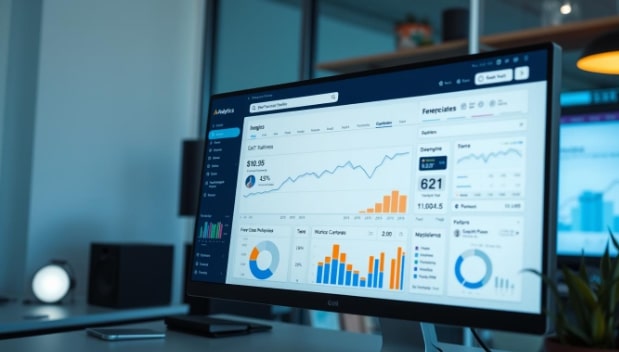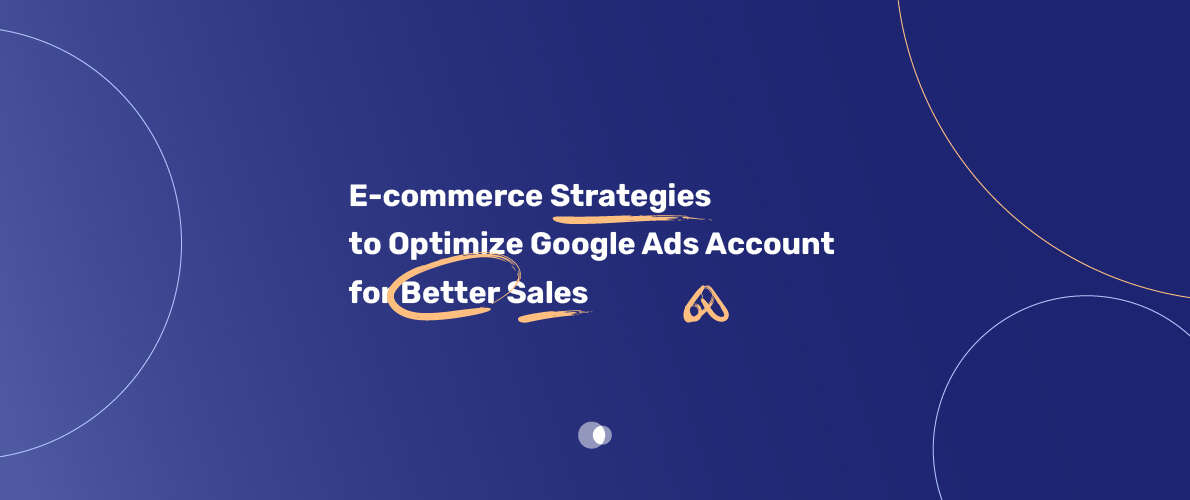In the fast-paced world of digital marketing, optimizing your Google Ads account is key. It helps drive success and boosts your return on investment (ROI). But, Google Ads can be tricky, with many pitfalls that can harm your campaigns. Learning to Optimize Google ads account is crucial for your campaign’s success and staying competitive.
Table of Contents
This guide covers the basics of Google Ads optimization. It gives you the tools to avoid common mistakes and get great results. You’ll learn about account structure, data-driven bidding, and more. This article is your guide to Google Ads success.

Key Takeaways
- Understand the importance of proper Google Ads account structure and organization
- Implement effective budget allocation and bidding strategies to maximize campaign performance
- Leverage audience targeting and segmentation techniques to reach your ideal customers
- Avoid common optimization pitfalls that can undermine your advertising efforts
- Utilize keyword research, ad copy testing, and landing page optimization to drive increased conversions
- Integrate performance tracking and analytics to make data-driven decisions
- Automate bid adjustments and rules to optimize your campaigns efficiently
Understanding the Fundamentals of Google Ads Account Structure
Creating a well-organized Google Ads account is key to successful ad campaigns. Knowing the basics of Google Ads structure helps marketers. They can then organize their accounts better, set up settings, and manage their hierarchy to get better results.
Campaign Organization Best Practices
Managing your Google Ads account well is important. Follow these tips to organize your campaigns:
- Group campaigns by product, service, or marketing goal for a clear structure.
- Use campaign-level settings like budgets and bidding to improve performance.
- Make ad groups in each campaign focused to boost Quality Scores and ad relevance.
Essential Account Settings and Configurations
Changing your Google Ads account settings can really help your campaigns. Here are key settings to consider:
- Set up conversion tracking to see how well your ads are doing.
- Use audience targeting like demographics and interests to find your best customers.
- Adjust account-level settings like currency and billing to keep things running smoothly.
Account Hierarchy Management
Managing your Google Ads account hierarchy well can give you insights and make managing campaigns easier. Here’s how to do it:
| Hierarchy Level | Recommended Approach |
| Manager Account | Use the manager account to oversee multiple client accounts or different business units. |
| Client Account | Set up individual client accounts to organize campaigns and performance data by entity. |
| Campaigns | Group campaigns by product, service, or marketing objective for better optimization. |
| Ad Groups | Create tightly themed ad groups to improve ad relevance and Quality Scores. |
By learning about Google Ads account structure, marketers can improve their campaign organization. They can also optimize settings and manage their hierarchy better. This leads to better performance.
Proper Budget Allocation and Bidding Strategy Implementation
Effective PPC budget allocation and the right bidding strategies are key. They help you get the most from your ad spend. This way, you can get the best results while staying within your budget.
First, understand how your campaigns are doing. Look at your past data to see which ones are the most profitable. Then, put more money into those areas. This makes sure your ad spend is working hard for you.
Next, pick the right bidding strategies. Try out different methods like manual or automated bidding. Find what works best for your goals and budget. Keep tweaking your strategy to stay on top of market changes.
| Bidding Strategy | Best Use Case | Potential Benefits |
| Manual Bidding | Campaigns with specific CPA or ROAS goals | Greater control over bids, suitable for niche markets |
| Automated Bidding | Campaigns with flexible performance goals | Optimized for maximum conversions or revenue within budget |
| Combination Approach | Campaigns with both flexible and specific goals | Leverages the strengths of both manual and automated bidding |
By balancing your PPC budget allocation and choosing the right bidding strategies, you can manage your costs well. This ensures your Google Ads account optimization at its best within your budget.
Target Audience Selection and Segmentation Techniques
Getting the right audience is key to a successful Google Ads campaign. Knowing who to target and how to segment them makes your ads more effective. Let’s explore the main ways to pick and segment your audience.
Demographics and Interest Targeting
Demographic targeting lets you reach people based on age, gender, income, and education. This way, you can make ads that really speak to your audience. Interest-based targeting also helps, by focusing on what users like and do online. This way, you can find people who might actually want what you’re offering.
Geographic Targeting Optimization
Geotargeting is a powerful tool for narrowing down your audience. It lets you show ads to people in specific places, like countries or cities. By doing this, you can make sure your ads are seen by the right people, in the right places. This can help you use your ad budget more wisely and reach your most valuable customers.
Custom Audience Creation
- Use your customer data to make custom audiences. This could be email lists, website visitors, or social media followers.
- Custom audiences help you target people who already know and like your brand. This can lead to more sales.
- You can also make lookalike audiences. These are people who are similar to your current customers, helping you grow your reach.
By using these audience targeting and segmentation techniques, you can make sure your Google Ads reach the right people. This approach can make your ads more effective and help your business grow.
| Targeting Method | Benefits | Considerations |
| Demographics | Precise audience identificationTailored ad messagingImproved ad relevance | Availability of dataPotential audience limitations |
| Interests | Reaching engaged usersIncreased ad resonanceOpportunity for cross-selling | Accurate interest dataPotential audience overlap |
| Geotargeting | Localized ad deliveryMaximized ad budget utilizationIncreased ad relevance | Granular location dataPotential audience limitations |
| Custom Audiences | Targeting engaged usersIncreased conversion ratesOpportunity for retargeting | Availability of customer dataPotential audience saturation |
Avoid Common Mistakes in Optimize Google Ads Account
Google Ads can be tricky to handle, but avoiding common mistakes can help a lot. One key step is to find and fix mistakes that slow you down. This is crucial for getting the most out of your ads.
Many advertisers make errors in account management mistakes and optimization errors. Here are some big Google ads partner and how to dodge them:
- Bad Account Structure: A good structure is vital for managing your campaigns well. Make sure your campaigns, ad groups, and keywords are set up right. This helps your ads work better and makes fixing problems easier.
- Wrong Bid Strategies: Choosing the right bid strategy is key to spending your ad budget wisely. If your bidding doesn’t match your goals, you might not get the best results. This can lead to PPC troubleshooting issues.
- Bad Audience Targeting: Finding and reaching your perfect customer is essential. If you miss the mark on demographics, interests, or location, you’ll waste money and miss chances.
- Weak Keyword Research: Good keyword research is the base of a strong Google Ads plan. Skipping this step means you might not find the right keywords. This makes it hard to reach the right people and get quality leads.
- Bad Ad Copy and Landing Pages: Creating engaging ad copy and optimizing landing pages is crucial. If your ads and landing pages aren’t up to par, you’ll miss out on conversions.
By fixing these common Google Ads pitfalls, optimization errors, and account management mistakes, you can make your ads work better. This will help you succeed in the long run.
Keyword Research and Match Type Selection
Good Google Ads campaigns start with solid keyword research. Knowing what your audience searches for helps you pick the best keywords. This makes your ads more effective.
Negative Keyword Implementation
Negative keywords are key to a better Google Ads account. They’re terms you don’t want your ads to show for. Using them right can make your ads more relevant and save you money.
Search Term Analysis
It’s important to check which search terms trigger your ads. This helps you find new keywords and trends. It also shows what your audience is really looking for.
Match Type Strategy Development
Google Ads has different match types for various needs. A good strategy mixes broad, phrase, exact, and negative match types. This balances wide reach with precise targeting.
| Match Type | Description | Pros | Cons |
| Broad Match | Ads may show for searches with synonyms, related terms, and other variations of your keywords. | Casts a wide net, potentially reaching more relevant users. | Increased risk of irrelevant impressions and clicks. |
| Phrase Match | Ads will show for searches that contain the exact phrase of your keyword, with additional words before or after. | Provides more targeted reach than broad match. | Limits flexibility compared to broad match. |
| Exact Match | Ads will only show for searches that exactly match your keyword. | Ensures the highest relevance and target precision. | Narrows the audience reach compared to broader match types. |
| Negative Keywords | Terms you exclude from your ad targeting to prevent your ads from appearing for irrelevant searches. | Improves campaign efficiency and return on investment. | Requires ongoing monitoring and adjustment. |
Using keyword research, negative keywords, search term analysis, and a smart match type strategy boosts your Google Ads. This way, you get the most out of your ads and your investment.
Ad Copy Creation and Testing Methodology
Making great ad copywriting is key to better Google Ads results. Create ads with catchy headlines, persuasive descriptions, and clear calls-to-action. Use A/B testing to find out what works best and keep improving.
Don’t hesitate to try new things with ad variants. Experiment with different styles, messages, and layouts to see what your audience likes. Watch your ad performance closely, like click-through rate (CTR) and conversion rate, to learn and improve.
- Write headlines that grab attention and show what makes you special.
- Make your ad descriptions clear and exciting, focusing on what your product or service offers.
- Use strong calls-to-action to get people to take action.
- Do A/B testing often to find the best ad copy parts.
- Keep tweaking your ad variants based on how well they do.
“Successful ad campaigns are built on a foundation of well-crafted, data-driven copywriting.” – John Doe, Digital Marketing Strategist
By sticking to these ad copy creation and testing methodology tips, you’ll boost your Google Ads success. You’ll get more clicks, conversions, and better ad performance optimization.

Landing Page Optimization and Quality Score Improvement
In Google Ads, successful campaigns need well-optimized landing pages and high quality scores. Focusing on these areas can make your ad spend work harder. This leads to better results.
Page Load Speed Optimization
Page load speed is key for landing page optimization. Slow pages hurt user experience, leading to high bounce rates and low quality scores. To improve, consider:
- Optimize image and video file sizes
- Minimize external scripts and stylesheets
- Use browser caching and content delivery networks (CDNs)
- Keep an eye on page speed and fix issues
Content Relevancy Guidelines
Your landing page’s content must match the keywords, ad copy, and user intent. Make sure it’s valuable and informative. This meets the user’s needs and encourages action.
Mobile Responsiveness Checks
In today’s mobile world, your landing pages must work well on mobile. Check if your pages look good on different screens and devices. This improves user experience and quality scores, as Google favors mobile-friendly content.
| Optimization Strategy | Impact on Quality Score |
| Page Load Speed Optimization | Significant positive impact |
| Content Relevancy Guidelines | Crucial for improving quality scores |
| Mobile Responsiveness Checks | Strongly correlated with higher quality scores |
By using these strategies for landing page optimization and quality score improvement, you can make your Google Ads campaigns better. This leads to improved performance and more return on investment.
Performance Tracking and Analytics Integration
Unlocking your Google Ads campaigns’ full potential means keeping a close eye on performance and analyzing data well. By linking Google Analytics with your account, you gain access to valuable insights. These insights can greatly enhance your ad effectiveness.
It’s key to track important metrics like click-through rates, conversion rates, and ROI. Google Analytics offers tools to monitor these stats. This helps you make informed decisions and improve your strategies.
Deeper data analysis can reveal more about your campaigns. You can learn about user behavior, find top-performing ads, and see how different channels perform. This knowledge helps you refine your campaign tracking and conversion tracking for better outcomes.
“Effective data analysis is the key to unlocking the true potential of your Google Ads campaigns.” – Marketing Strategist, Jane Doe
Linking your Google Ads and Google Analytics accounts lets you track and analyze your campaigns smoothly. This empowers you to make choices that lead to real success. With the right tools, your ads will always be on the right track.

- Regularly monitor key performance metrics like click-through rates, conversion rates, and ROI.
- Leverage Google Analytics to uncover deeper insights into user behavior and campaign effectiveness.
- Optimize your campaign tracking and conversion tracking to make data-driven decisions.
- Integrate your Google Ads and Google Analytics accounts for seamless performance monitoring and analysis.
Automated Rules and Bid Adjustments
In the fast-paced world of Google Ads, automated rules and bid adjustments are key. They help advertisers manage their accounts better. This ensures ads reach the right people at the right time.
Schedule-Based Bid Modifications
Smart advertisers use schedule-based bidding. They adjust bids for different times to get the most out of their ads. This way, they spend their budget wisely, improving their ROI.
Device-Specific Bid Strategies
In today’s world, focusing on mobile devices is crucial. Automated bidding lets advertisers tailor bids for desktop, tablet, and mobile. This ensures ads reach users on the platforms they use most, boosting engagement.
Performance-Based Automation
Performance automation adapts to market changes and user habits. Advertisers set rules to adjust bid adjustments based on KPIs. This keeps campaigns effective without constant manual tweaking.
| Feature | Benefits |
| Automated Bidding | Enhances efficiency and profitability by adjusting bids based on performance data |
| Bid Adjustments | Allows for granular control over budget allocation and campaign optimization |
| Schedule-Based Bidding | Capitalizes on peak user activity periods to maximize return on investment |
| Device-Specific Strategies | Tailors ad delivery to the devices where target audience is most likely to engage |
| Performance Automation | Adapts campaigns to changing market conditions and user behavior for optimal results |
Using automated bidding and bid adjustment features helps advertisers manage Google Ads better. It saves time and resources for other marketing tasks. Finding the right mix of schedule-based bidding and device-specific strategies is key to success.
Conclusion
Success in Google Ads comes from avoiding common mistakes. Understanding account structure, budget, and bidding is key. Targeting the right audience is also crucial for impactful PPC campaigns.
Good keyword research, ad copy, and landing pages are vital. Using performance tracking and analytics helps refine campaigns. Automated rules and bid adjustments can also boost ROI.
This article offers a roadmap to Google Ads success. It helps advertisers in the fast-changing PPC world. By following these best practices, businesses can meet their marketing goals and grow their customer base.
FAQ
1)What are the key tips for optimizing a Google Ads account?
To optimize a Google Ads account, avoid common mistakes. Understand how to structure your account. Use the right budget and bidding strategies.
Choose your target audience wisely. Do thorough keyword research and pick the right match types.
2)How can I organize my Google Ads campaigns effectively?
Organize your campaigns by following best practices. Set up your account settings correctly. Manage your account hierarchy well.
3)What are some effective techniques for budget allocation and bidding strategy implementation?
To allocate budgets and set bids, optimize your ad spend. Use the right bidding strategies for your goals. Keep an eye on your budgets and bids to adjust as needed.
4)How can I improve my target audience selection and segmentation?
Improve your audience selection by targeting demographics and interests. Optimize your geographic targeting. Create custom audiences for better ad relevance.
5)What are some common mistakes to avoid when optimizing a Google Ads account?
Avoid poor account structure and ineffective budget allocation. Don’t choose the wrong target audience or do inadequate keyword research.
6)How can I conduct effective keyword research and match type selection?
For effective keyword research, use negative keywords and analyze search term data. Develop a match type strategy to improve ad relevance.
7)What are the best practices for creating and testing ad copy?
Write engaging ad copy and test it to improve performance. Keep refining your ads based on data insights.
8)How can I optimize my landing pages and improve my Quality Score?
Optimize landing pages for speed and content relevance. Ensure they are mobile-friendly. This improves user experience and ad performance.
9)What are the key performance metrics I should track and how can I integrate analytics?
Track important metrics like campaign and account performance. Use Google Analytics for deeper insights to optimize your campaigns.
10)How can I utilize automated rules and bid adjustments to improve my campaign efficiency?
Use automated rules and bid adjustments for better efficiency. This includes schedule-based and device-specific bidding, and performance-based automation.



